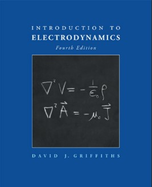The Clausius-Mossotti equation (Prob. 4.41) tells you how
Chapter 4, Problem 43P(choose chapter or problem)
Problem 43P
The Clausius-Mossotti equation (Prob. 4.41) tells you how to calculate the susceptibility of a nonpolar substance, in terms of the atomic polarizability α. The Langevin equation tells you how to calculate the susceptibility of a polar substance, in terms of the permanent molecular dipole moment p. Here’s how it goes:
(a) The energy of a dipole in an external field E is u = −p · E = −pE cos θ (Eq. 4.6), where θ is the usual polar angle, if we orient the z axis along E. Statistical mechanics says that for a material in equilibrium at absolute temperature T , the probability of a given molecule having energy u is proportional to the Boltzmann factor,
The average energy of the dipoles is therefore
Where and the integration is over all orientations (θ : 0 → π; φ : 0 → 2π). Use this to show that the polarization of a substance containing N molecules per unit volume is
Equation 4.73
That’s the Langevin formula. Sketch P/Np as a function of pE/kT .
(b) Notice that for large fields/low temperatures, virtually all the molecules are lined up, and the material is nonlinear. Ordinarily, however, kT is much greater than pE. Show that in this régime the material is linear, and calculate its susceptibility, in terms of N, p, T , and k. Compute the susceptibility of water at 20?C, and compare the experimental value in Table 4.2. (The dipole moment of water is 6.1 × 10−30 C·m.) This is rather far off, because we have again neglected the distinction between E and Eelse. The agreement is better in low-density gases, for which the difference between E and Eelse is negligible. Try it for water vapor at 100?C and 1 atm.
Reference equation 4.6
Reference prob 4.41
In a linear dielectric, the polarization is proportional to the field: P = ϵ0χeE. If the material consists of atoms (or nonpolar molecules), the induced dipole moment of each one is likewise proportional to the field p = αE. Question: What is the relation between the atomic polarizability α and the susceptibility χe? Since P (the dipole moment per unit volume) is p (the dipole moment per atom) times N (the number of atoms per unit volume), P = Np = NαE, one’s first inclination is to say that
Reference equation 4.70
And in fact this is not far off, if the density is low. But closer inspection reveals a subtle problem, for the field E in Eq. 4.30 is the total macroscopic field in the medium, whereas the field in Eq. 4.1 is due to everything except the particular atom under consideration (polarizability was defined for an isolated atom subject to a specified external field); call this field Eelse. Imagine that the space allotted to each atom is a sphere of radius R, and show that
Equation 4.71 and 4.72
Equation 4.72 is known as the Clausius-Mossotti formula, or, in its application to optics, the Lorentz-Lorenz equation.
Reference equation 4.1
Reference equation 4.30
Unfortunately, we don't have that question answered yet. But you can get it answered in just 5 hours by Logging in or Becoming a subscriber.
Becoming a subscriber
Or look for another answer
